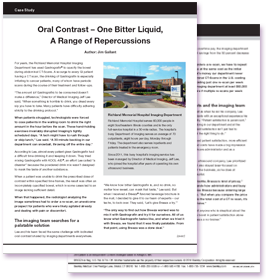
Cut costs; increase throughput, raise those HCAPS scores! If you work in healthcare administration today, this is your reality. It's a juggling act and a hard one at that. Nearly 1,500 hospitals were penalized in 2013 under Medicare's quality incentive program - more than in the prior year when the program was first introduced, and with steeper penalties.
Not surprising. It's kind of hard to increase throughput while slashing budgets and giving patients the care and attention they expect and deserve. Conversely, it's hard to elevate satisfaction scores without investing in personnel, equipment, and other items that make for the very best patient experience possible.
However, the facilities that focus on caring for patient as a person, instead of as a test to be performed, or disease to be cured, or an occupied bed to turn over as quickly as possible, end up coming out ahead in both throughput and productivity despite the costs involved in providing an extra caring touchpoint. Engaging patients drives the bottom line.
Jeff Lee, the Director of Medical Imaging at Richland Memorial Hospital is a testament to this.
One of the biggest challenges he faced in his CT department was the negative impact on workflow, payroll, and revenues as a result of patients' difficulty with drinking oral contrast despite attempts to help it taste better with powdered drink mixes.
Lee's focus on improving the patient experience led him to Breeza, a flavored beverage designed with a bitterness blocker to help make oral iodinated contrast more palatable. Lee realized that while this was an initial added expenditure, it was an investment in the quality of care for his patients that also helped him improve workflow and control of operating costs in a problematic area.
It was a night and day difference. With improved palatability of contrast came fewer complaints and better drinking compliance from patients. This in turn helped keep scans on schedule, resulting in fewer overtime hours for It was a night and day difference. With improved palatability of contrast came fewer complaints and better drinking compliance from patients. This in turn helped keep scans on schedule, resulting in fewer overtime hours for technologists. Because patients were better able to comply with drinking instructions, Lee also saw a 50% decrease in abdominal re-scans ordered by radiologists.
According to Lee, "When a radiologist orders a re-scan, we have to repeat the test free of charge at the same cost as the initial scan, That’s money our department never recoups. At around $3.00 per bottle, Breeza is kind of pricey, but when you compare the price of Breeza per bottle to the total cost of a CT re-scan, it’s actually quite inexpensive. I would tell anyone who is skeptical about the cost of Breeza that the boost in patient satisfaction alone makes investing in Breeza a no-brainer.”
Read more about his experience before and after Breeza and let us know about a small change or investment in patient satisfaction that made a world of difference for your facility.
click image to read case study

Mary Lang Pelton
Director of Marketing Communications

